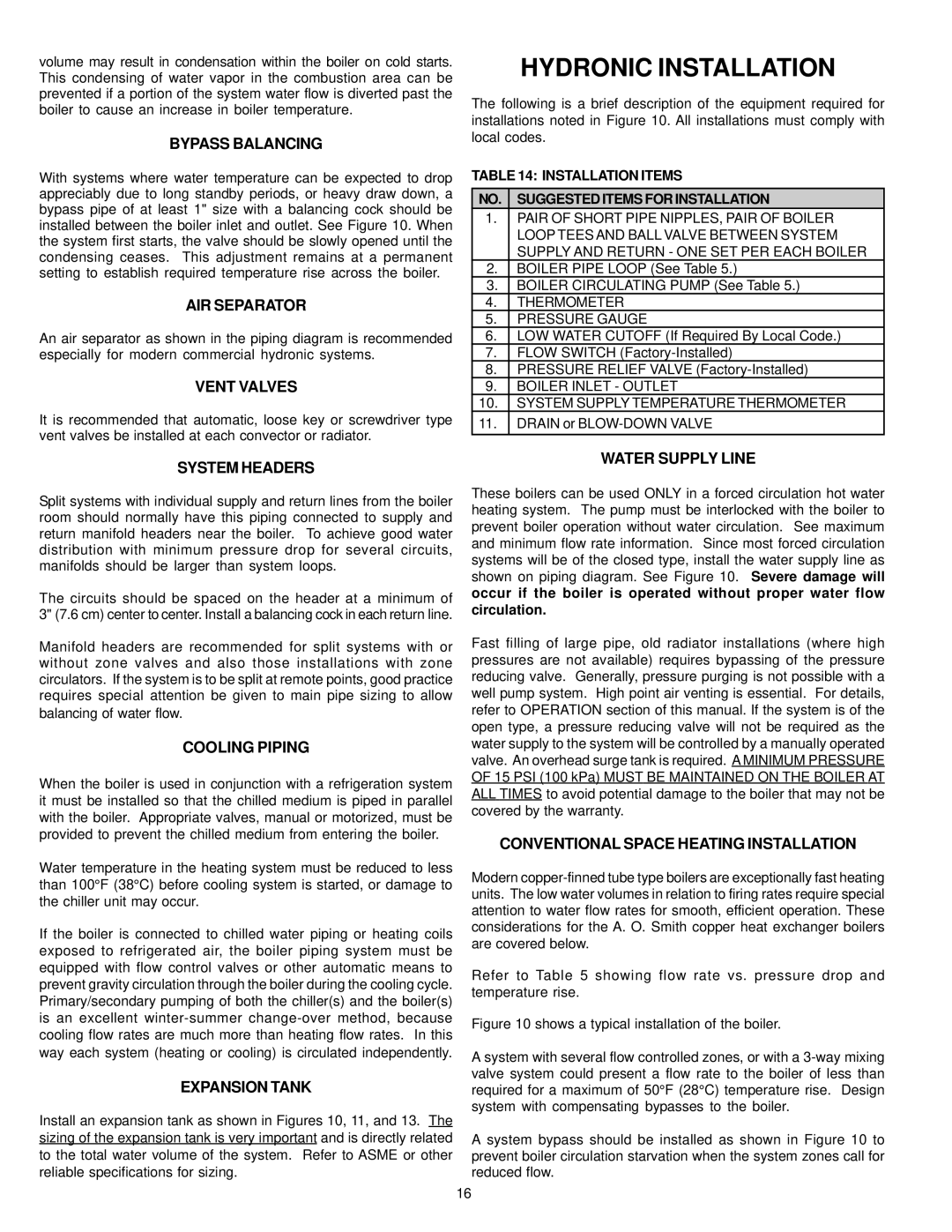volume may result in condensation within the boiler on cold starts. This condensing of water vapor in the combustion area can be prevented if a portion of the system water flow is diverted past the boiler to cause an increase in boiler temperature.
BYPASS BALANCING
With systems where water temperature can be expected to drop appreciably due to long standby periods, or heavy draw down, a bypass pipe of at least 1" size with a balancing cock should be installed between the boiler inlet and outlet. See Figure 10. When the system first starts, the valve should be slowly opened until the condensing ceases. This adjustment remains at a permanent setting to establish required temperature rise across the boiler.
AIR SEPARATOR
An air separator as shown in the piping diagram is recommended especially for modern commercial hydronic systems.
VENT VALVES
It is recommended that automatic, loose key or screwdriver type vent valves be installed at each convector or radiator.
SYSTEM HEADERS
Split systems with individual supply and return lines from the boiler room should normally have this piping connected to supply and return manifold headers near the boiler. To achieve good water distribution with minimum pressure drop for several circuits, manifolds should be larger than system loops.
The circuits should be spaced on the header at a minimum of 3" (7.6 cm) center to center. Install a balancing cock in each return line.
Manifold headers are recommended for split systems with or without zone valves and also those installations with zone circulators. If the system is to be split at remote points, good practice requires special attention be given to main pipe sizing to allow balancing of water flow.
COOLING PIPING
When the boiler is used in conjunction with a refrigeration system it must be installed so that the chilled medium is piped in parallel with the boiler. Appropriate valves, manual or motorized, must be provided to prevent the chilled medium from entering the boiler.
Water temperature in the heating system must be reduced to less than 100°F (38°C) before cooling system is started, or damage to the chiller unit may occur.
If the boiler is connected to chilled water piping or heating coils exposed to refrigerated air, the boiler piping system must be equipped with flow control valves or other automatic means to prevent gravity circulation through the boiler during the cooling cycle. Primary/secondary pumping of both the chiller(s) and the boiler(s) is an excellent
EXPANSION TANK
Install an expansion tank as shown in Figures 10, 11, and 13. The sizing of the expansion tank is very important and is directly related to the total water volume of the system. Refer to ASME or other reliable specifications for sizing.
HYDRONIC INSTALLATION
The following is a brief description of the equipment required for installations noted in Figure 10. All installations must comply with local codes.
TABLE 14: INSTALLATION ITEMS
NO. | SUGGESTED ITEMS FOR INSTALLATION |
1. | PAIR OF SHORT PIPE NIPPLES, PAIR OF BOILER |
| LOOP TEES AND BALL VALVE BETWEEN SYSTEM |
| SUPPLY AND RETURN - ONE SET PER EACH BOILER |
2. | BOILER PIPE LOOP (See Table 5.) |
3. | BOILER CIRCULATING PUMP (See Table 5.) |
4. | THERMOMETER |
5. | PRESSURE GAUGE |
6. | LOW WATER CUTOFF (If Required By Local Code.) |
7. | FLOW SWITCH |
8. | PRESSURE RELIEF VALVE |
9. | BOILER INLET - OUTLET |
10. | SYSTEM SUPPLY TEMPERATURE THERMOMETER |
11. | DRAIN or |
WATER SUPPLY LINE
These boilers can be used ONLY in a forced circulation hot water heating system. The pump must be interlocked with the boiler to prevent boiler operation without water circulation. See maximum and minimum flow rate information. Since most forced circulation systems will be of the closed type, install the water supply line as shown on piping diagram. See Figure 10. Severe damage will occur if the boiler is operated without proper water flow circulation.
Fast filling of large pipe, old radiator installations (where high pressures are not available) requires bypassing of the pressure reducing valve. Generally, pressure purging is not possible with a well pump system. High point air venting is essential. For details, refer to OPERATION section of this manual. If the system is of the open type, a pressure reducing valve will not be required as the water supply to the system will be controlled by a manually operated valve. An overhead surge tank is required. A MINIMUM PRESSURE OF 15 PSI (100 kPa) MUST BE MAINTAINED ON THE BOILER AT ALL TIMES to avoid potential damage to the boiler that may not be covered by the warranty.
CONVENTIONAL SPACE HEATING INSTALLATION
Modern
Refer to Table 5 showing flow rate vs. pressure drop and temperature rise.
Figure 10 shows a typical installation of the boiler.
A system with several flow controlled zones, or with a 3-way mixing valve system could present a flow rate to the boiler of less than required for a maximum of 50°F (28°C) temperature rise. Design system with compensating bypasses to the boiler.
A system bypass should be installed as shown in Figure 10 to prevent boiler circulation starvation when the system zones call for reduced flow.
16
